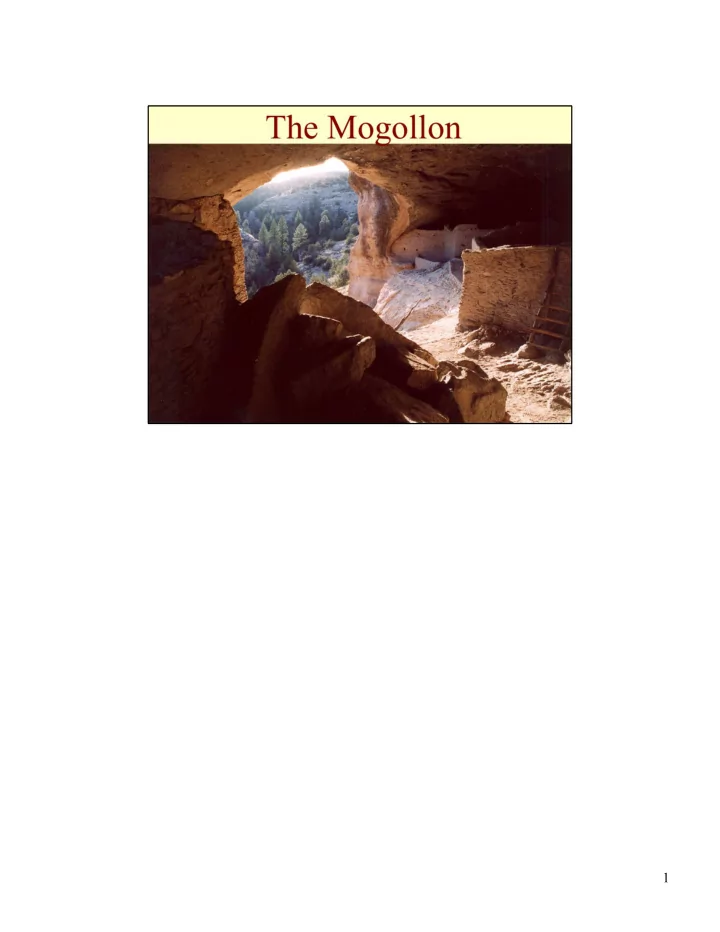

1
The Mogollon Culture evolved in the southwestern corner of New Mexico and extended along the Mogollon Rim into east‐central and southeast Arizona and southward into the Chihuahua region of northern Mexico. This map is decep?ve in that it makes it look like the Mogollon occupied an en?re territory uniformly; however, they really stuck to the upland areas and leD large lowland areas alone. 2
Unlike the Hohokam or the Ancestral Puebloans, the Mogollon were only Part‐?me farmers. They also moved around more, so their villages were only semi‐permanent. 3
This is the textbook defini?on of the Mogollon period. It is based on the appearance of par?cular type of poKery and the construc?on of D‐shaped pithouses. Can you see how limited this is? It would be like defining American culture from the 1980s to the 2000s as the “Compact Disk” period. This hides the large variability that occurs during this ?me. I, for example, sported quite the wavy hair in the 1980s. Today – not so much. 4
Pithouses among the Mogollon were very similar to those built by the Hohokam and Ancestral Puebloans, except they tended to be D‐shaped rather than rectangular or circular. Also, since this part of the southwest lacks the caliche that is common in the Phoenix valley, most pithouses lacked plastered floors. This makes them very difficult to iden?fy when we are excava?ng them. You have to find a layer of dirt that is slightly more packed than the surrounding dirt. 5
Like other pithouses, Mogollon structures required lots of wood. This was not as large of a problem with the Mogollon, who lived in forested areas, as it would be with the Hohokam or Puebloans. 6
7
Mogollon seKlements during this ?me were ?ny by any standard. SeKlements with simultaneous occupa?on of 4‐6 dwellings would have had a popula?on of about 30 people total. This number is too small to reliably provide marriage partners or to offer access to diverse resources that might have been needed to offset poor crops or lack of success in hun?ng. These groups would have had to interact with others on a fairly regular basis. 8
Again – everything is based on poKery!! This period was one of great stability among the Mogollon. Hun?ng and some gathering con?nued to be important even though agriculture was adopted everywhere. Pithouses were smaller but each seKlement had more structures, perhaps indica?ng that the basic coopera?ng group was the nuclear family, several of which occupied the same hamlet. Most seKlements were built near arable land rather than in defensive loca?ons. 9
The appearance of surface pueblos during this ?me suggests that the Puebloans are having a more important influence on the Mogollon region during this ?me. Some have argued that the Puebloans engaged in a “takeover”, but there is liKle evidence of warfare or conquest. 10
As with the Hohokam and the Puebloans, this period was one of massive change for the Mogollon. In many parts of the Mogollon region large sites are built for the first ?me, possibly due to an influx of people migra?ng from the Puebloan region. Sites near arable land tend to be abandoned in favor of more defensive loca?ons. One theory –as resources become more unevenly distributed, people mass in those areas and try to defend what they have from outsiders. 11
This is famous site located along the Gila River near Silver City, NM. The structures were built into natural caves in volcanic tuff in the end of the 13 th century. These structures would have been excellent defensive loca?ons, but not very good for growing crops. 12
The Mimbres Branch represent one group of Mogollon (like Californians are one branch of Americans). The Mimbres were so successful as both farmers and poKery makers that their popula?ons expanded to the point where their region (Mimbres Valley) could no longer support them all. As a result, their group collapses. Note the holes in the two bowls. This is not random breakage. These holes were punched by Mogollon people when they were burying their dead. The broken bowls were placed over the faces of the deceased to allow their spirits to pass on. 13
One of the most well‐known Mogollon sites, Three Rivers Petroglyphs, seems to be a veritable Mecca for people who came to carve petroglyphs. No other site in the SW comes close to the number of petroglyphs found here. 14
A Mogollon Fish. I like this one, for some reason. 15
The variety in petroglyph designs suggests that people from many different areas are congrega?ng here. Maybe to trade? 16
Why do you think buildings would be burned before they were leD? 17
Recommend
More recommend